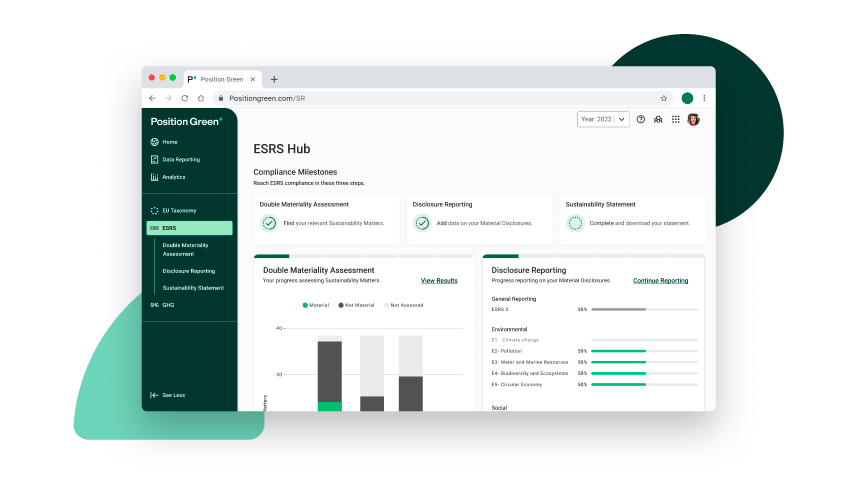ESRS double materiality assessment: Your software solution explained

The Corporate Sustainability Reporting Directive (CSRD) and European Sustainability Reporting Standards (ESRS) are currently occupying a lot of sustainability professionals’ headspace. Companies operating within the EU are now tasked with achieving compliance with new legislation. This involves thoroughly examining the European Financial Reporting Advisory Group’s (EFRAG) guidelines to develop processes that meet these requirements.
Position Green offers a purpose-built software solution for the ESRS, with built-in expertise provided by seasoned sustainability advisors. Within this article, Felicia Gustafson, who as Group Product Management leads our Solutions development, and Olivia Krall, a seasoned Manager and Sustainability Advisor, share key insights into the thoughtful decisions made during the software’s development process.
Pinpointing the purpose of the double materiality assessment feature
The double materiality assessment is the first key to ESRS success. Position Green’s software solution has been developed to support companies in documenting the process, as well as identifying and understanding what sustainability matters and disclosure requirements they need to report on. For a seamless experience, the identified material disclosures can then be added to the company reporting set-up within the software. Additionally, the double materiality assessment functionality is designed to prepare companies for the mandatory assurance process, providing documentation and traceability. Storing the result of the double materiality assessment in the software, the annual follow-up and adjustment of material topics and disclosures will be a much smoother operation.
Methodology for developing the software functionality
In developing the methodology for the double materiality assessment, we have carefully considered the requirements outlined in the ESRS 1, alongside the guidelines provided by EFRAG. By filling in the mandatory input fields, you ensure compliance with all obligatory reporting matters. The optional input fields are based on ESRS and EFRAG guidelines, and include drop-down alternatives based on Position Green’s advisors expertise and best practices.

“Using the DMA module, you are able to more conveniently comply with the requirements attached to the process.”
Felicia Gustafson – Position Green
The basis for the embedded impact materiality scoring
The double materiality assessment consists of two parts – the impact materiality and the financial materiality. The impact materiality assessment criteria is based on the ESRS, as well as established frameworks such as the UN Guiding Principles for Businesses and Human Rights and the OECD Guidelines for multinational enterprises:
- Scale: How grave the impact is or would be
- Scope: How widespread the harm/good would be or is for the relevant stakeholder group
- Remediability: How difficult it is to counteract or reverse the harm
- Likelihood: How likely it is that the impact would occur
The following scoring method that establishes the severity of a matter is based on Position Green expertise, rooted in the human rights due diligence process.
- Impact materiality is calculated based on the severity of the impact x the likelihood of the impact occurring.
- Severity is calculated in the following ways:
Negative impact: severity = the average of scale, scope and remediability
Positive impact: severity = the average of scale and scope
Foundation for the built-in financial materiality scoring
The financial materiality scoring methodology embedded in the software is based on ESRS requirements as well as best practice and expertise from Position Green’s in-house advisors. It consists of the following criteria:
- Size of financial effect: Informed by the approximated magnitude of the financial impact
- Likelihood: How likely it is that a financial effect will materialise within a set timeframe
An assured software solution
Position Green’s software is developed based on the requirements outlined in the ESRS and guidelines published by EFRAG. Companies conducting their double materiality assessment through the software have had their result approved by certified auditors.
Using the double materiality assessment module, you are able to more conveniently comply with the requirements attached to the process. We recommend utilising our full ESRS solution including functionalities for disclosure reporting and the sustainability statement.

Felicia Gustafson
Group Product Manager
Position Green


